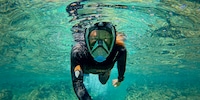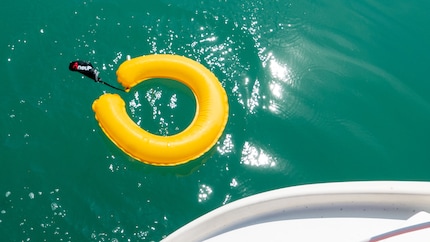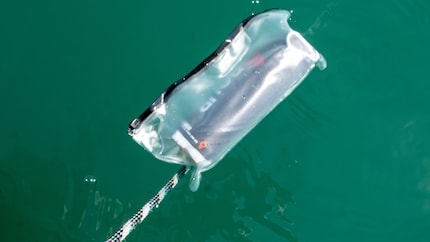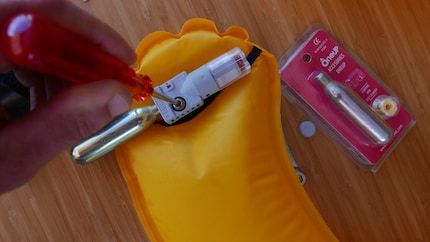
Product test
The Cressi snorkel mask’s surprisingly comfortable
by Siri Schubert

With the OneUP in your luggage, you are prepared for emergencies in the water. The compact reel becomes a lifebuoy in a matter of seconds. A big hit? Has it raised any questions for you?
The proof of the pudding is in the eating. So into the water with the OneUP. It has a Velcro cover in which the rolled-up lifebuoy is inserted. About two seconds after contact with water, a salt tablet has dissolved, which triggers the release mechanism. Gas flows into the ring from a CO2 cartridge. Whereby ring is not quite correct. It floats on the water in a horseshoe shape, bulging and yellow. This is what the process looks like in slow motion.
A major advantage of this handy item is that it can be thrown far and accurately. At 370 grams, it sits comfortably in the hand and offers little surface area for the wind to attack before it unfurls in the water. The buoyancy force of the OneUP is 110 newtons. This actually qualifies it as a companion for the inflatable boat tour on the river, where it has been mandatory to carry one life-saving device per person since this year.
As I said: actually. As a self-inflating device, the OneUP still falls through the legal cracks at the moment, writes Oliver Wyss from OneUP Rescue AG.
In this form, it also does not replace the lifebuoy prescribed for boats with a propulsion power of more than 30 kW or a sail area of more than 15 square metres. It does not have a buoyant line of at least ten metres in length. This will change with the OneUP PRO model, which will soon be available and will have the corresponding line and approval from the Association of Shipping Authorities.
The legal situation is one thing, the practical use is another topic. Certification or not, the OneUP provides plenty of buoyancy and remains airtight once inflated. Even 48 hours after use, it was still as full as when I first used it. Its strength lies in the fact that it can be taken anywhere and at any time to make a big impression in an emergency. When camping at the nearest lake, on long journeys and in very small luggage.
You can carry the OneUP attached to a carabiner to help others or yourself. However, you then run the risk of being like Masus004, who writes in his product rating: "Unfortunately unintentionally triggered by splashing water at Aareböötle." To prevent this from happening, a transparent protective cover is included, the zip of which makes you suspicious.
I have pressed the OneUP packed in it under water several times without a drop penetrating. The manufacturer writes: "In the practical test, OneUP in the protective cover did not trigger after 30 minutes, neither in heavy rain nor in water." I think it's a shame that there is no attachment option for the snap hook on the cover. This would make it easier to have it on your person without risking accidental triggering.
If you want to travel by air with the OneUP, you should transport the CO2 cartridge separately and register it with the airline in advance. According to the valid regulations of the International Civil Aviation Organisation, it is permitted to take it with you, but ultimately the airline decides.
As with all rescue equipment that has an automatic release mechanism, the question of durability arises.
This requires a little patience and it is not easy to empty it completely. While holding the valve open with a pointed object, press the gas out of the ring as completely as possible. Once the safety screw is back in place, you can replace the salt tablet and the CO2 cartridge. Correctly folded and rolled up, it can now be twisted back into its cover and is ready for the next use.
There's room for the OneUP in your luggage and the best rescue tool in an emergency is whatever you have to hand. The form factor enables targeted throws over a greater distance than is possible with a normal lifebuoy. This allows you to help others or provide yourself with additional safety on and around the water. The lack of certifications is currently still a downer for water sports enthusiasts. This is sometimes the case with innovations.
Simple writer and dad of two who likes to be on the move, wading through everyday family life. Juggling several balls, I'll occasionally drop one. It could be a ball, or a remark. Or both.
Based on the Inland Navigation Ordinance (Art. 134), only inflatable lifejackets with collars or 'classic lifebuoys' are recognised as individual rescue equipment on inflatable boats, provided they comply with SN EN ISO certification. However, inflatable lifebuoys with automatic or manual release are not listed in the law.




The tablet must be replaced at the latest two years after purchase or when the corresponding indicator has turned red. After four years, you should replace the OneUP, writes the manufacturer. It will probably work for much longer, as long as you pay attention to the release mechanism. If you haven't used it for years, you should at least carry out a function test. The fact that you trigger the OneUP does not mean that you have to dispose of it afterwards. It can be repacked with spare parts.

The Spanish sea rescue organisation SASEMAR uses the OneUP and its developers are working with other partners to make the waters safer. Be it with solar-powered emergency pillars on the beach that automatically alert rescue services as soon as someone reaches for the OneUPs stored there. Or with the idea of dropping the rescue equipment at the scene by drone. The OneUP works in salt and fresh water and is a useful gadget in the long term. A big hit in a small format - and perhaps a saviour at some point.

Ariel Universal+
72 Washing cycles, Washing powder